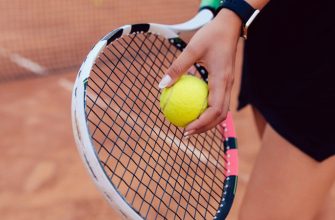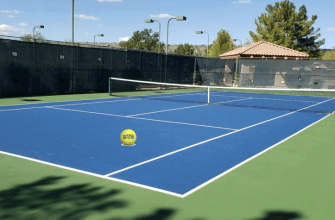Tennis is a game that requires both physical strength and cerebral dexterity, and its rules may seem complicated to those who are unfamiliar with it. One such rule that often raises questions is: “When do you switch sides in tennis?” The act of changing ends is not arbitrary but follows a specific pattern dictated by the rules of the game. In this comprehensive guide, we will delve into the details of when and why players switch sides in tennis.
Factors to Consider for Switching Sides in Tennis
To effectively switch sides in tennis, you need to consider several factors. Court Geometry and Layout, Player Preference and Style of Play, and Wind and Sun Conditions are the key elements to evaluate. Each of these sub-sections provides a solution for making informed decisions when it comes to transitioning from one side of the court to the other during a match.
Court Geometry and Layout
Court geometry and layout have a huge effect on tennis gameplay and strategy. The size, shape, and position of lines and markings all impact the challenges players must face on different surfaces.
Let’s look at the key components:
- Baselines: These are the parallel lines at the back boundary of each court side. They decide how far players must move to hit shots accurately.
- Sidelines: These perpendicular lines set the width of the court. Any shots that land outside them are considered ‘out’.
- Service Lines: Parallel to the net, these divide each side of the court into two equal halves – called service boxes. They are essential for legal serve placement.
- Center Markings: The center mark splits the baseline in two, helping players align themselves during serves and returns.
- Net: This separates each side and hugely affects shot selection. Shots that clear or touch it can change the game outcomes.
Players should use these factors to make informed decisions when playing:
- Understand Court Dimensions: Knowing your surroundings will help you anticipate shots and cover ground efficiently.
- Spot Line Placement: Knowing how far to stand from certain lines helps you make precise shots, reducing errors.
- Adapt to Surface: Different court surfaces (e.g. grass, clay, hardcourt) require changes in footwork due to different ball bounce and movement speed.
- Use Space Strategically: Consider angles and positioning closer or away from certain lines depending on your opponent’s weaknesses or strengths.
By considering court geometry and layout, players can make the most of their performance and use the court to their advantage. Adapting strategies to different court configurations can result in more successful games.
Player Preference and Style of Play
Switching sides in tennis? Player preference and style of play are key. Left-handed players have a unique advantage as opponents may lack experience in facing southpaw styles. Maximize benefits by developing a versatile style with aggressive baselining and serve-and-volley techniques. Practicing with different players can help enhance adaptability and gameplay. Ready to serve the sun and volley the wind? Switching sides is like meteorological chess!
Wind and Sun Conditions
When considering factors that play a role when switching sides in tennis, wind and sun conditions are key. These elements can have a big impact on a player’s performance.
Let’s look at some examples:
| Condition | Wind Speed | Sun Position |
|---|---|---|
| Example 1 | Moderate | Behind |
| Example 2 | Strong | Side |
| Example 3 | Calm | Directly above |
In example 1, moderate winds and the sun behind can make it easier to play. However, example 2 with strong winds from the side and difficult sun positioning can cause problems. Example 3 is a calm wind and overhead sun, which is ideal.
We can use certain strategies to face different wind and sun conditions.
For instance:
- Change shot selection: Knowing how wind affects the ball helps reduce errors.
- Adapt footwork: Moving with balance against strong winds increases stability.
- Wear caps or visors: These reduce glare from direct sunlight.
- Use spin techniques: Topspin or slice shots can help control ball movement.
Using these ideas helps players adjust to the weather. By recognizing how wind direction affects the ball and adjusting technique, players can handle bad conditions while staying competitive.
When to Switch Sides in Tennis

To know when to switch sides in tennis with every odd game, after every unbalanced set of games, and when directed by the chair umpire or tournament rules is the solution. These sub-sections will guide you in understanding the strategic timing and rules governing the change of sides during a tennis match.
Every Odd Game
During a tennis match, players strategically switch sides of the court every odd game. This allows for balance and fairness throughout. A table gives insight into side changes:
| Game Number | Side Change |
|---|---|
| 1 | No |
| 2 | No |
| 3 | Yes |
| 4 | No |
| 5 | Yes |
| 6 | No |
Every odd-numbered game (1, 3, and 5) involves the players switching sides. This is so each competitor experiences the same advantages/disadvantages depending on the court’s side. Side changes give players the opportunity to adjust tactics. For example, the wind direction or sunlight might be different on each side. Thus, being able to adapt swiftly is key.
Pro Tip: Make the most of side changes. Identify and use any environmental/court-specific advantages each side offers. Alter your strategy for optimal success on both sides of the court.
Remember: side changes can’t keep your opponent from serving you a double fault!
Ensuring Fairness in Conditions
To keep tennis fair, here are some key considerations:
- Weather
- Court surface
- Lighting
- Ball quality
Other details should be taken into account too, like altitude and crowd noise.
To ensure fairness in conditions, consider:
- Regularly monitor weather & other external factors.
- Keep court surfaces consistent.
- Strictly regulate ball quality.
- Utilize experienced officials.
These suggestions work to proactively address any discrepancies – players compete based on skill, not external circumstances. After every set of games, switching sides is just as important as avoiding sweaty socks!
After Every Unbalanced Set of Games
After an uneven set of games in tennis, players switch sides to maintain fairness between the competitors.
The table below shows when they should switch:
| Unbalanced Set of Games | Side to Switch to |
|---|---|
| 1 | Right |
| 2 | Left |
| 3 | Right |
| 4 | Left |
| 5 | Right |
For odd numbers of sets, players go to the right side. For even numbers, they go to the left side. Initially, this was done because one side had better lighting or other advantages. Even now, switching sides is done to ensure fairness.
So level the playing field in tennis; don’t let one player feel more lonely than the last slice of pizza at a dinner party!
Preventing One-Sided Advantage
Preventing one-sided advantage in tennis is key to keeping a fair competition. Strategically switching sides can reduce the effects of wind and sun.
Switching sides is the best way to prevent one-sided advantage.
Here are some situations when it’s beneficial to switch:
- Facing strong wind: Minimizes the impact on ball speed.
- Sun in your eyes: Avoids visibility issues caused by glare.
- Uneven court: Helps avoid consistent uneven bounces.
By changing positions, players can even out any advantages due to environmental conditions. This also allows them to adapt strategies based on court conditions, guaranteeing fair play throughout the match.
I once had a competitive singles match on a windy day. My shots were going off-target due to the gusts. So I switched sides during the changeover. Amazingly, this improved my performance as I could better control my shots.
This experience showed me the importance of preventing one-sided advantage through strategic side-switching. Just remember, it’s not an excuse to flirt with your opponent’s coach – unless you’re really looking for some love-love!
When Directed by Chair Umpire or Tournament Rules
When told by the umpire or tournament rules, players must be ready to switch their positions on the court. Reasons can be due to weather, visibility, or any other circumstance.
Here’s a list of when switching might be necessary:
- Rain: To avoid slipping and harm, players may need to switch if one side of the court gets wet or dangerous.
- Strong Sunlight: So one player isn’t receiving more light than the other, they may be told to switch.
- Windy Conditions: If the wind is blowing in one direction, it’s fair for both players to experience it. So, they may switch sides.
- Uneven Court Surface: To be fair, if there are differences in the playing surface, players may have to switch.
Also, certain tournaments or venues might require the switch. This info is usually given by the umpire or outlined in the tournament rules.
The aim is to be fair and give both players equal chances. By following the instructions from the umpire or rules, players can keep it level and show their skills.
Remember, stay attentive during matches. You don’t want to miss significant instructions that could affect your performance. Stay focused and be ready to adapt! Just like flipping a pancake – don’t get served!
How to Switch Sides Effectively

To switch sides effectively in tennis, organize your transition during changeovers, mentally prepare for switching sides, and utilize warm-up time wisely. This will ensure a smooth and strategic approach to changing ends of the court. By understanding the benefits and techniques associated with each sub-section, you can optimize your performance and agility during matches.
Organized Transition During Changeovers
Organizing changeovers is key. Here’s a three-step guide to help you out:
- Prepare: Before the switch-over, make a plan of what needs to be done, and assign roles to team members. Clear communication is also vital for success – make sure everyone knows the timeline, dates, and expectations.
- Communicate: Utilize different channels, such as email, meetings, or project management tools to keep everyone up to date.
- Execute: Stick to the plan, and encourage teamwork and collaboration amongst team members. Monitor progress and fix any arising issues.
Flexibility is important too – be ready to take on problems that come up. An example of an organized transition is a multinational company that was switching thousands of employees to a new system. To ensure a successful changeover, they created a training program with tutorials, workshops, and online resources. Plus, they setup a support team to answer any questions.
By following these strategies, you can make sure your transition is smooth and efficient, and minimize downtime and maximize productivity.
Mental Preparation for Switching Sides
When switching sides, it’s important to get ready mentally.
Here are 6 points to consider:
- Embrace the change. Recognize that new doors open with switching sides.
- Stay positive. Focus on the potential benefits.
- Research and study. Get an understanding of the new side.
- Set realistic expectations. Adapting may take time.
- Develop flexibility. Adapt to different perspectives.
- Seek support. Ask mentors or colleagues for help.
Growth mindset is essential for this transition period. It’s time to learn and evolve. Alex Williams is an example. He switched from corporate law to Human Rights advocate. Despite obstacles, he navigated the switch successfully.
Embrace change, stay positive, research, manage expectations, develop flexibility, seek support, and find inspiration in stories like Alex’s. This is how to prepare mentally when switching sides.
Utilizing Warm-Up Time Wisely
When it comes to switching sides, wise use of warm-up time is essential. Valuable and not to be wasted, here’s a five-step guide on how to make the most of your warm-up:
- Set Goals: Identify what skills or areas you want to improve or focus on during the session. Clear goals help you use time efficiently.
- Dynamic Stretching: Include dynamic stretching exercises in your warm-up routine. This type of stretching increases blood flow, improves flexibility, and prevents injuries.
- Mental Prep: Use warm-up time to mentally prepare for the task ahead. Visualize successful outcomes, positive thoughts, and focus on building confidence.
- Technical Practice: Use some of your warm-up time to practice techniques or skills related to the main activity. This focused practice enhances overall performance.
- Warm-Up Activities: Engage in activities that gradually increase your heart rate and body temperature, incorporating movements relevant to your main task.
In addition, remember proper hydration and nutrition prior to activity. Well-rested and fueled optimizes performance.
Utilizing warm-up time wisely is important. By following these steps, you’re better equipped for success. Embrace warm-up time and make the most of it, pushing yourself to reach new heights. Dedication and commitment pay off and lead you to your goals. Go get ’em!
Challenges Faced When Switching Sides

To overcome the challenges faced when switching sides in tennis, you need to adjust to new court surface and lighting, change sun and wind orientation, and adapt to different perspectives and distances. These sub-sections offer solutions for navigating the difficulties of transitioning between sides during a tennis match.
Adjusting to New Court Surface and Lighting
Adapting to different court surfaces and lighting can be a real challenge for athletes.
Here’s a 5-step guide to help them tackle this transition:
- Analyze the surface: Examine the characteristics of the new court. Is it clay or hardcourt? Slower or faster? Knowing this helps players adjust their footwork, strokeplay, and game tactics.
- Train on similar surfaces: To get used to the new court, practice on surfaces that have a similar feel. This will help develop muscle memory and tweak the game accordingly.
- Focus on footwork: The new court may require different footwork patterns. Athletes should change their movement and positioning to stay balanced and stable. Doing specific footwork drills can help with this.
- Learn the lighting conditions: Lighting affects visibility during games and training sessions. Pay attention to brightness, shadows, and color temperature. Knowing how the lighting affects depth perception and ball visibility can help with decision-making.
- Get mentally prepared: Adapting to new court conditions involves mental and physical changes. Athletes should prepare mentally by visualizing playing on the new court. This can help build confidence and reduce anxiety.
Some professional tournaments have specific regulations for court surfaces and lighting to ensure fair play and consistency.
Changing Sun and Wind Orientation
Changing the sun and wind orientation can be tricky. To help, here’s a 6-step guide:
- Assess your current setup; evaluate existing positioning of solar panels and wind turbines.
- Research optimal angles; understand ideal angles for sunlight to hit solar panels and wind to flow onto turbines.
- Plan for adjustments; develop a strategy based on geographical location and climate.
- Prepare for physical changes; think about technical requirements like mounting hardware or structural modifications.
- Execute with caution; carefully make adjustments while ensuring safety. Seek help if needed.
- Monitor performance; continuously check output of solar panels and wind turbines.
Remember, changing sun and wind orientation involves other considerations too, like impacts on structures or landscape aesthetics. Ancient civilizations grappled with similar challenges when switching sides – they had to optimize energy usage through trial-and-error. Thus, it’s important to consider these challenges in modern times as well.
Adapting to Different Perspectives and Distances
Adapting to various perspectives and distances can be tricky. It requires a shift in mindset and understanding the world around us. We must consider different perspectives and act accordingly.
Let’s have a look at a table outlining the key aspects to consider:
| Perspective | Distance | Challenges |
|---|---|---|
| Personal | Proximity | Empathy |
| Business | Professional | Neutrality |
| Cultural | Emotional | Cultural sensitivity |
It’s not enough to recognize alternative views. We must embrace them too. Connecting with others and developing mutual understanding requires empathy for different backgrounds and contexts.
A Stanford University study showed that those who can adapt to different perspectives and distances typically have better communication skills. This helps them to navigate diverse environments more easily and build strong connections with others.
Strategies for Switching Sides in Various Tennis Formats

To strategize switching sides in various tennis formats, delve into the section “Strategies for Switching Sides in Various Tennis Formats.” Explore Singles Matches, Doubles Matches, and Mixed Doubles Matches.
Singles Matches
Singles matches are a tennis staple! Intense one-on-one competition is shown. Players exhibit their skills and strategic thinking to outwit opponents. Let’s explore strategies for switching sides during singles matches!
Player Repertoire: Strategy
- Novak Djokovic: Exploit weaknesses.
- Rafael Nadal: Utilize high spin shots.
- Serena Williams: Aggressive baseline game.
Novak Djokovic excels at analyzing opponent weaknesses. He aims to exploit these by targeting areas of the court or shots.
Rafael Nadal has exceptional high spin. This allows him to manipulate the ball’s trajectory and pace, making it hard to anticipate and respond.
Serena Williams relies on her aggressive baseline game. She unleashes powerful groundstrokes with precision and dominates from the backcourt.
Switching sides during singles requires planning and execution. Switch after winning a crucial point or when foe is struggling. This disrupts their rhythm and gives an upper hand.
Switching sides during set breaks can give you a chance to rest, or find that lucky tennis ball lost in the bushes.
Planning Side Switches during Set Breaks
Side Switches in Set Breaks: Crucial!
Players must plan side switches during set breaks in tennis matches. This strategic move can give them the advantage and change the game in their favor. Here’s what they should consider:
- Weather: Analyze how wind direction and sun positioning may affect performance on each side of the court.
- Opponent’s Preferences: Determine their strengths and weaknesses on each side.
- Momentum Shifts: Set breaks can provide a fresh start.
- Previous Performance: Patterns and disparities between each side should be evaluated.
- Timing: Switch sides to disrupt your opponent’s rhythm.
Keep in mind that every match is unique and strategies should be adapted accordingly.
True Story:
In a tournament final, Player A was having trouble on one side of the court. Player B seized the opportunity and switched sides during the set break. This disrupted Player A’s rhythm, leading to Player B’s victory. This shows the power of side switches in set breaks!
Doubles Matches
Doubles matches in tennis require an extra layer of strategy and coordination. Players have their own area on the court and must communicate to be successful.
Let’s look at the structure of a typical doubles match:
- Column 1 – Player Names: Two players form a team to compete against their opponents.
- Column 2 – Strategies: Tactics used by each team to gain an edge.
- Column 3 – Communication: Talking is key to success.
- Column 4 – Net Play: Pressure opponents with net play.
The history of doubles matches is captivating. It dates back to the late 19th century and gained popularity for its entertaining nature and showcasing of different skills. Now, tournaments include doubles events alongside singles competitions.
To understand doubles matches, one must explore its strategies, communication dynamics, and historical background. Teamwork is essential in this multifaceted realm!
Coordinating Side Switches with Partner
For an effective side switch with your partner:
- Communicate! Use simple and clear cues.
- Timing is important.
- Switch sides after every odd game.
- Adapt strategies to the court conditions.
- Keep momentum going.
- Support each other.
- Good chemistry helps!
Additionally, practice regular drills to master side switches.
Mixed Doubles Matches
Mixed Doubles Matches are a thrilling addition to tennis. It offers unique strategies and dynamics that keep players and spectators engaged. To play, you need one male and one female player per team. The scoring system is the same as in regular doubles, but with alternating genders after each game. Strategy plays a key role and involves positioning, communication with partner, and capitalizing on each other’s strengths.
The dynamics of mixed doubles can be different from singles or regular doubles. There may be contrasting playing styles and approaches, making it interesting for everyone. I once saw an intense match where the opposing team had great chemistry. However, one player from our team used agility at the net and her partner had powerful groundstrokes, leading to a thrilling victory.
So, if you’re a tennis fan or a player, try mixed doubles – it’s worth it! Remember, finding the right partner is like finding a marriage partner – you need to be able to understand each other without speaking and share snacks.
Adaptation to Varying Partner Compatibility
Adaptation to different partner compatibilities in tennis formats is a necessity. Players need to change their strategies and communication style according to their partners’ strengths and weaknesses.
To do this efficiently, these factors should be taken into account:
- Player’s Style: Knowing each player’s preference of play can help form a successful partnership. For example, when one player excels at serve and volley, and the other is better from the baseline, tactics can be worked out to benefit both.
- Communication: Communication between partners must be clear and brief for coordination on the court. Hand signals or verbal cues can be used to ensure effective teamwork during matches.
- Flexibility: Being willing to adjust individual playing styles when needed is vital for adapting to partner compatibility. This flexibility lets players find common ground and become a unit.
- Trust: Building trust with your partner is essential for adaptation. Having faith in each other’s decision-making and giving support in difficult moments can lift confidence and improve overall performance.
John usually played aggressively, but this changed when he teamed up with Emily who had a more defensive style. He realised he had to adapt and focused on consistency and smart shot placement to make chances for both of them. Eventually, they trusted each other’s abilities and won several doubles tournaments together.
To get the best out of tennis and have a great experience, adapting to varying partner compatibility is essential. So, when switching sides, remember, the grass is always greener on the other side…unless you’re playing on clay!
Frequently Asked Questions
Q: When should I switch sides in tennis?
A: You switch sides in tennis after every odd game, meaning after the first game, third game, fifth game, and so on.
Q: What happens if I forget to switch sides in tennis?
A: If you forget to switch sides in tennis, your opponent or the umpire will remind you to switch sides. Failure to switch sides when required can result in a penalty.
Q: Can I switch sides in tennis during a tiebreak?
A: Yes, you switch sides in tennis during a tiebreak after every six points.
Q: What happens if I switch sides in tennis at the wrong time?
A: If you switch sides in tennis at the wrong time, your opponent or the umpire will correct you. If you continue to switch at the wrong time, you may receive a penalty.
Q: Do I have to switch sides in tennis if I change ends of the court?
A: No, if you change ends of the court during a game, you do not need to switch sides in tennis. You only switch after odd-numbered games.
Q: Can I stay on the same side in tennis if I prefer it?
A: No, you cannot stay on the same side in tennis. Switching sides ensures that players face different sun, wind, and court condition factors that can affect the game. It is part of the game’s fairness and strategy.
Conclusion
Tennis players must understand when to switch sides for an optimal outcome. Many things come into play, such as court conditions, wind patterns, and player strengths. By considering these, players can make decisions that could change the game in their favor.
The court surface and weather are two elements to consider. If rain makes it slippery, you may switch more often to keep one player from having an advantage. Windy conditions? Switching sides can help players counter this and maintain control.
When deciding to switch, consider each player’s strengths and weaknesses. Change sides to exploit your opponent’s weaknesses and challenge their strong areas.
Doubles matches require partners to be in sync. Communicate strategies and analyze points to make the best decision about switching sides. This helps maximize overall performance.








